When you first see the Nitecore EDC31, it may not appear that special. But a closer look reveals its special secrets. A compact EDC flashlight with a touch of tactical flair, a rather unusual LED and a super simple control scheme.
You can find the German version of this review on my website: SammysHP Blog › Nitecore EDC31
The flashlight was provided by the manufacturer for this review. Thank you very much!

Overview of hardware
In addition to the flashlight itself, the packaging also contains some accessories:
- Lanyard
- Clip
- USB-C charging cable
- Manual (EN, DE, FR, RU, JP, KO, IT, UA, CN)
The battery is integrated, the clip already attached. The instructions are comprehensive and easy to understand.
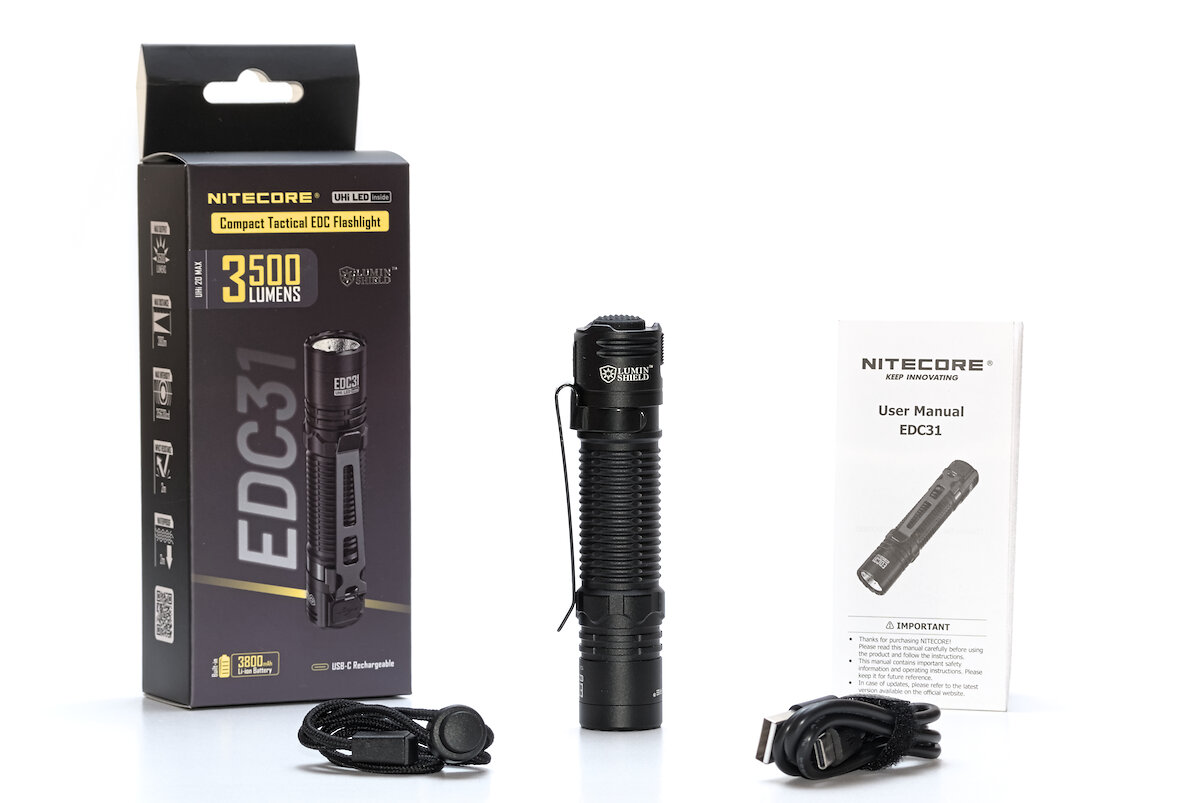
Because of the permanently installed 18650 battery, I compared the EDC31 with other lights that have a battery of this size. Although there are smaller lamps, the EDC31 is just below average, especially among the “tactical” lamps.
Length: 113.0 mm
Diameter (head): 23.0 mm
Diameter (battery tube): 22.6 mm
Diameter (clip): 21.7 mm
Diameter (tailcap): 24.0 – 25.2 mm
Weight (without clip): 92.3 g
The EDC31 is the smallest round model in the EDC series, only a few millimeters shorter than the EDC33. Compared to the EDC21, it is slightly longer and thicker.
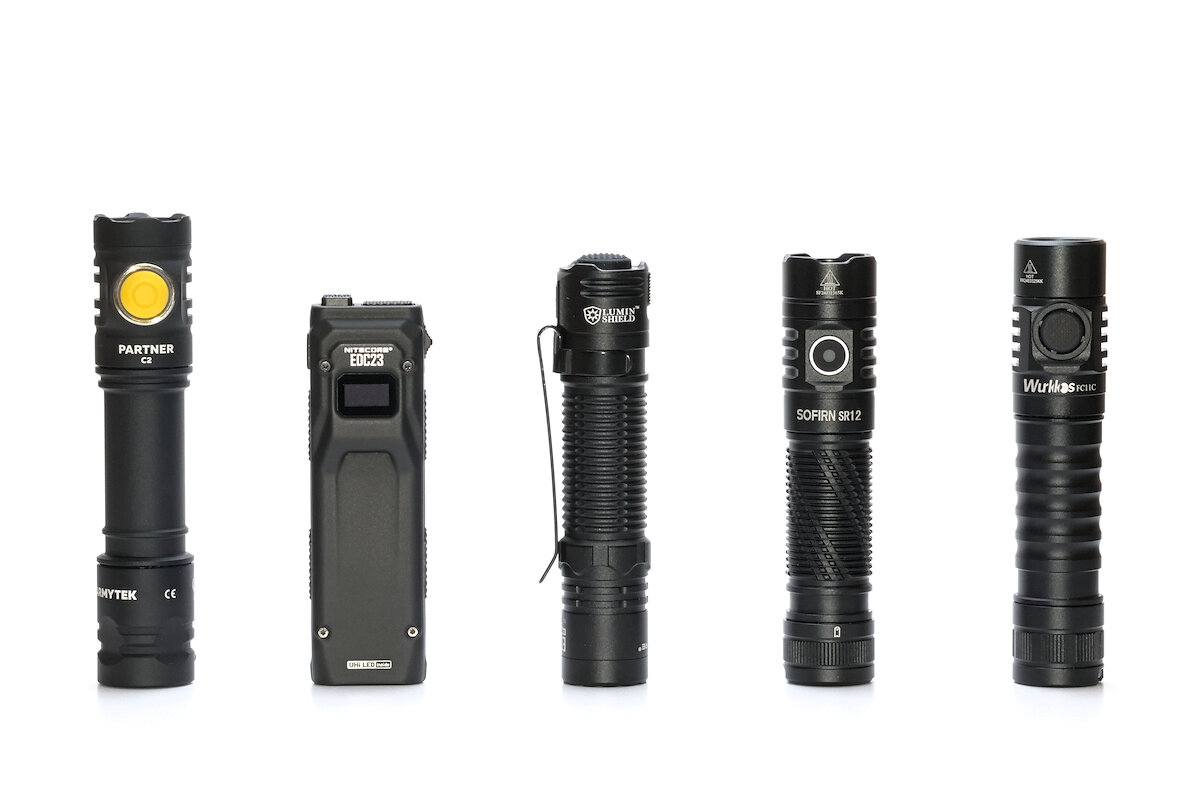
Armytek Partner C2 | Nitecore EDC23 | Nitecore EDC31 | Sofirn SR12 | Wurkkos FC11C
The ribbed battery tube provides a secure grip. The clip and some slightly flattened areas around the head and the protruding part of the charging connection make prevent the flashlight from rolling away on a flat surface.
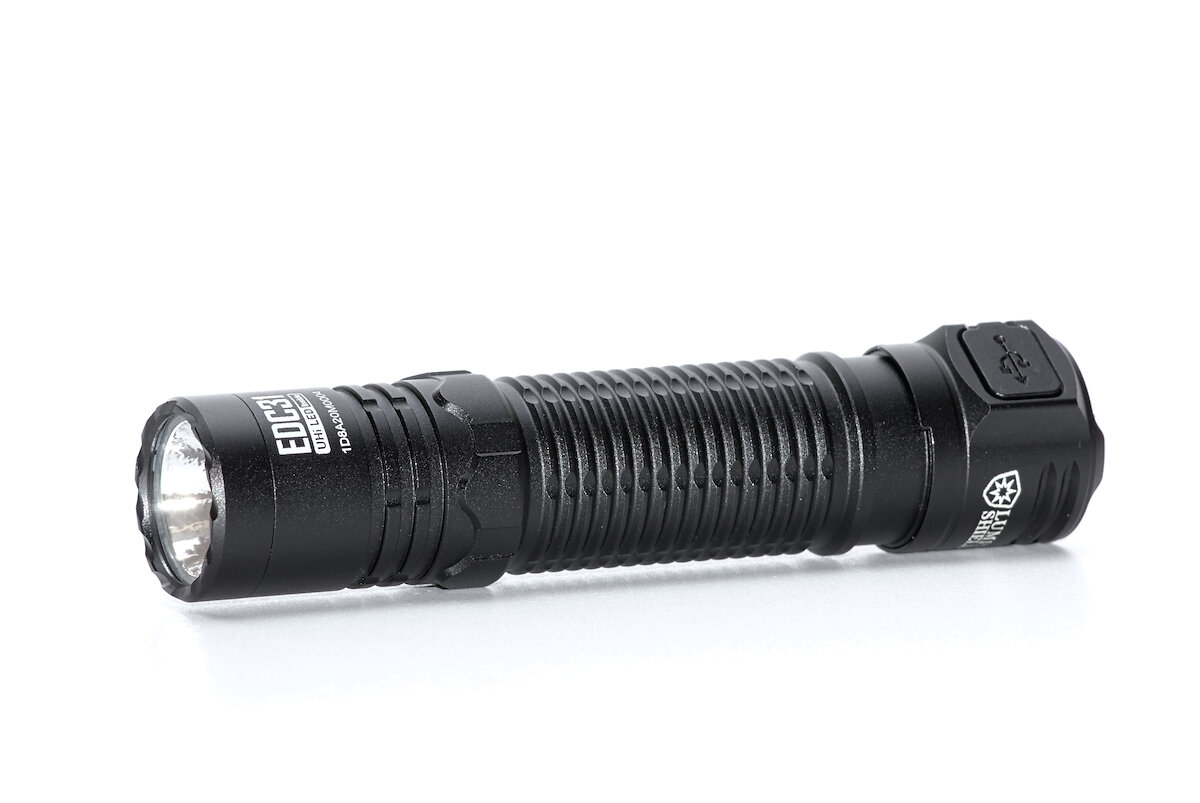
The bezel is kind of crenelated, which is helpful to see if the light is turned on when it stands on its head. However, the bezel – like the rest of the flashlight – is made of aluminum, so it is better not to use it as a striking tool.
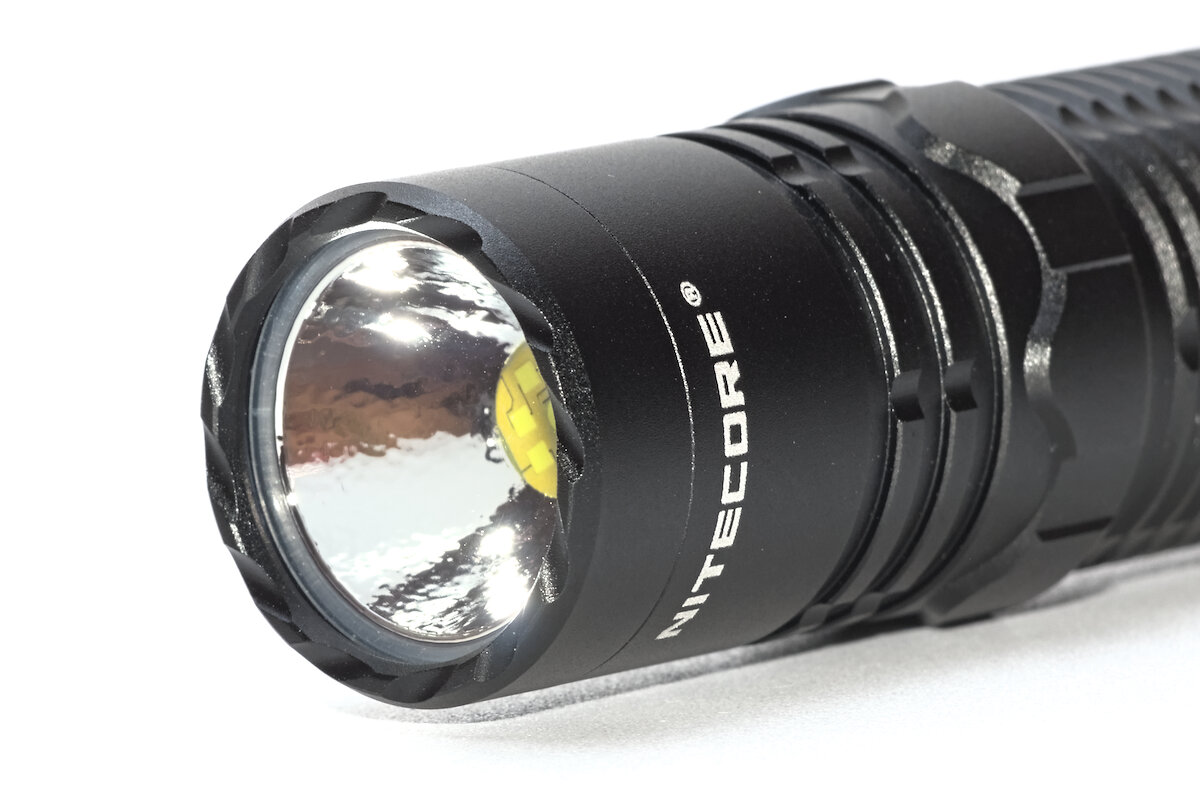
The flashlight has a large, two-stage electronic tail switch. Right next to it there are four LEDs to indicate the state of charge. Unfortunately the button protrudes slightly beyond the three protrusions of the tailcap, so that tailstand is impossible.
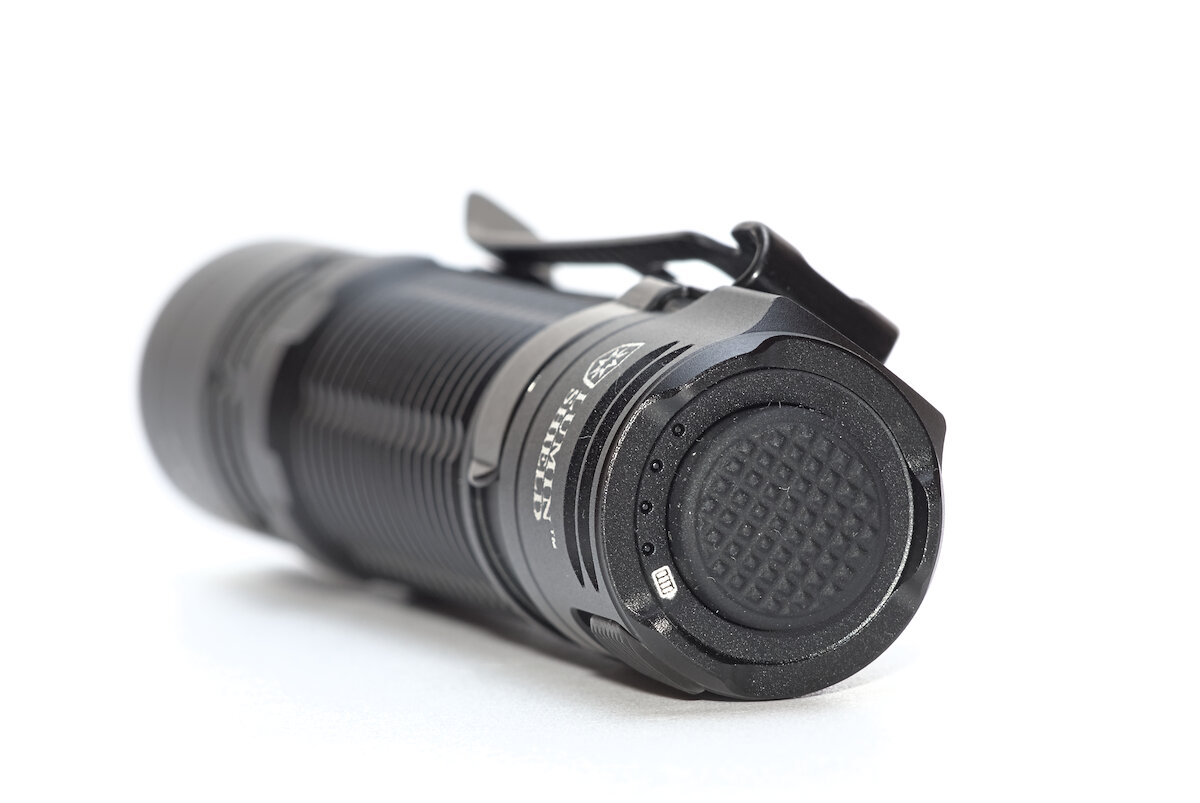
A slide switch on the side of the tailcap can be used to lock the flashlight and thus protect it from being switched on accidentally.
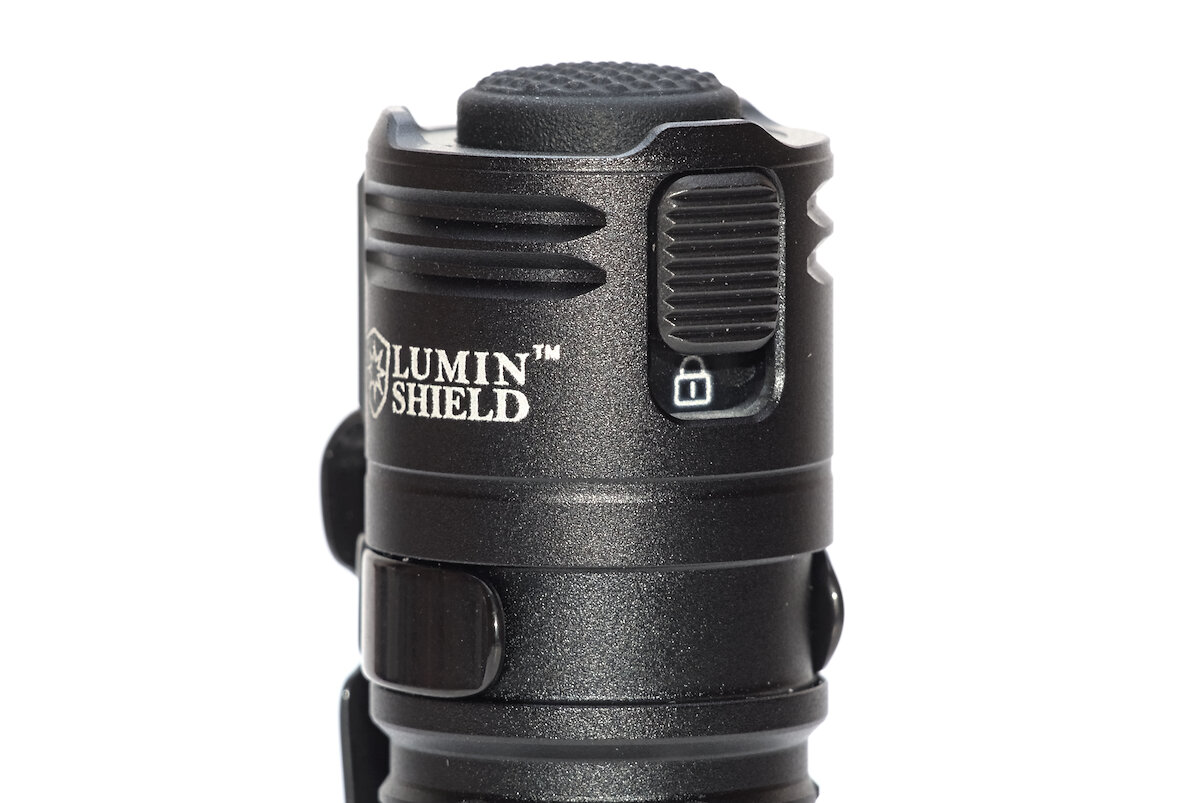
The supplied clip is simply attached to the back of the flashlight and sits sufficiently tight. The large opening makes it easier to use, but sometimes feels a little annoying.
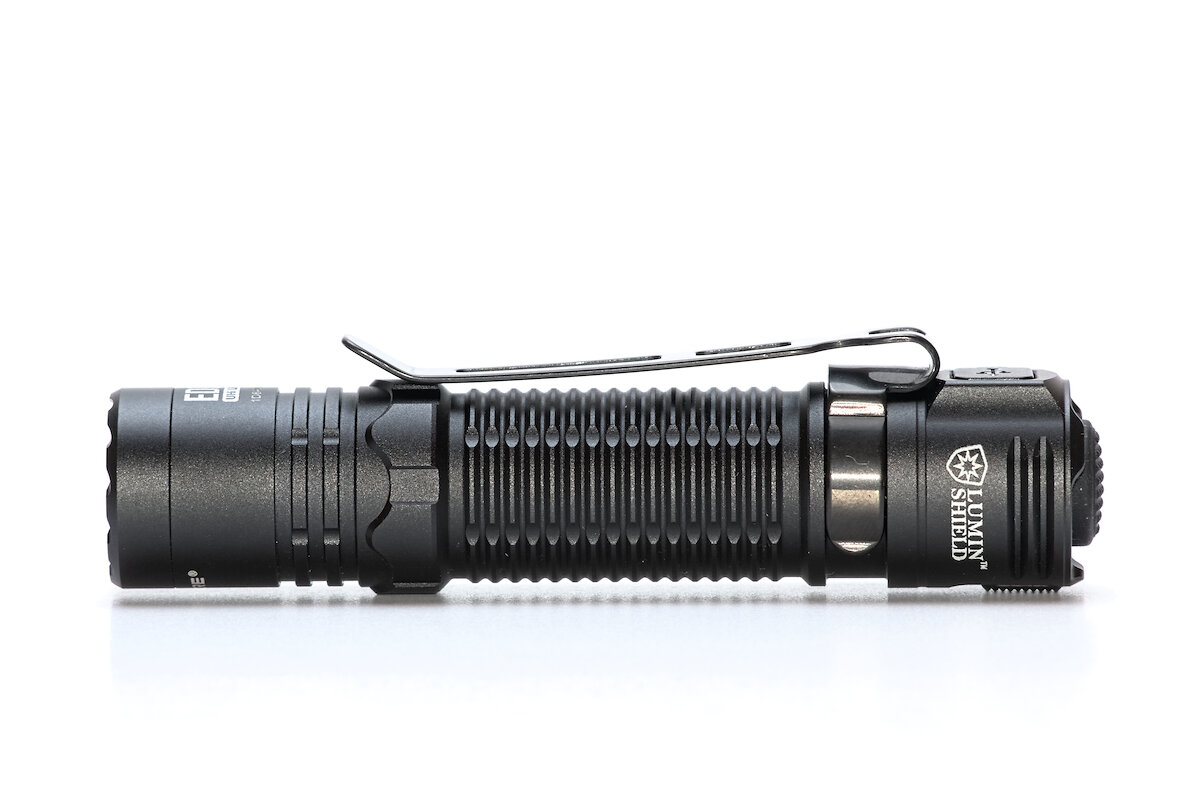
There is no extra hole for attaching a lanyard to the flashlight. But the instructions describe how the strap can be attached to the hole in the clip.
The attachment of the clip is indexed so it cannot turn freely.
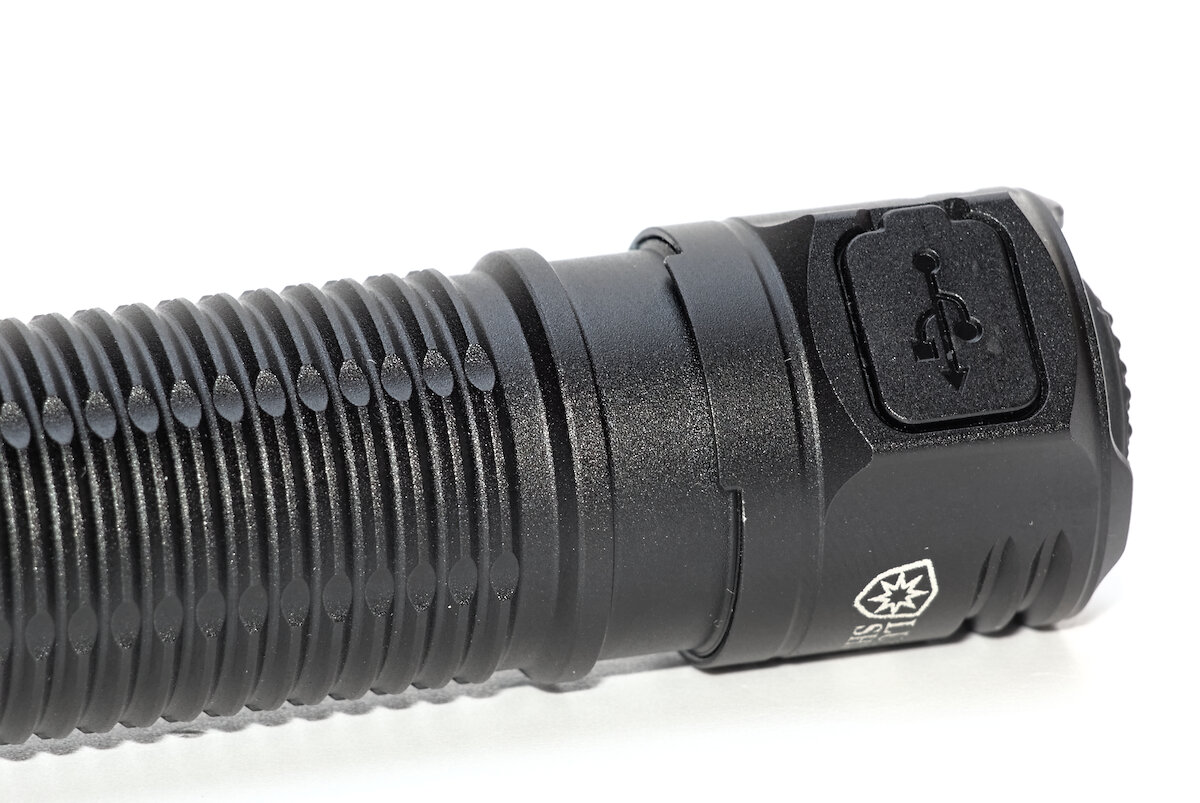
The permanently integrated battery is charged via a USB-C port at the end of the flashlight. The battery capacity is specified as 3800 mAh, which is unusually high for an 18650-sized battery.

A cover provides protection against dirt and water. Its outer side is made of solid plastic, while the inner half is made of silicone. This provides a good seal, but is very easy to open and close. When closed, it is flush with the body, making accidental opening rather unlikely.
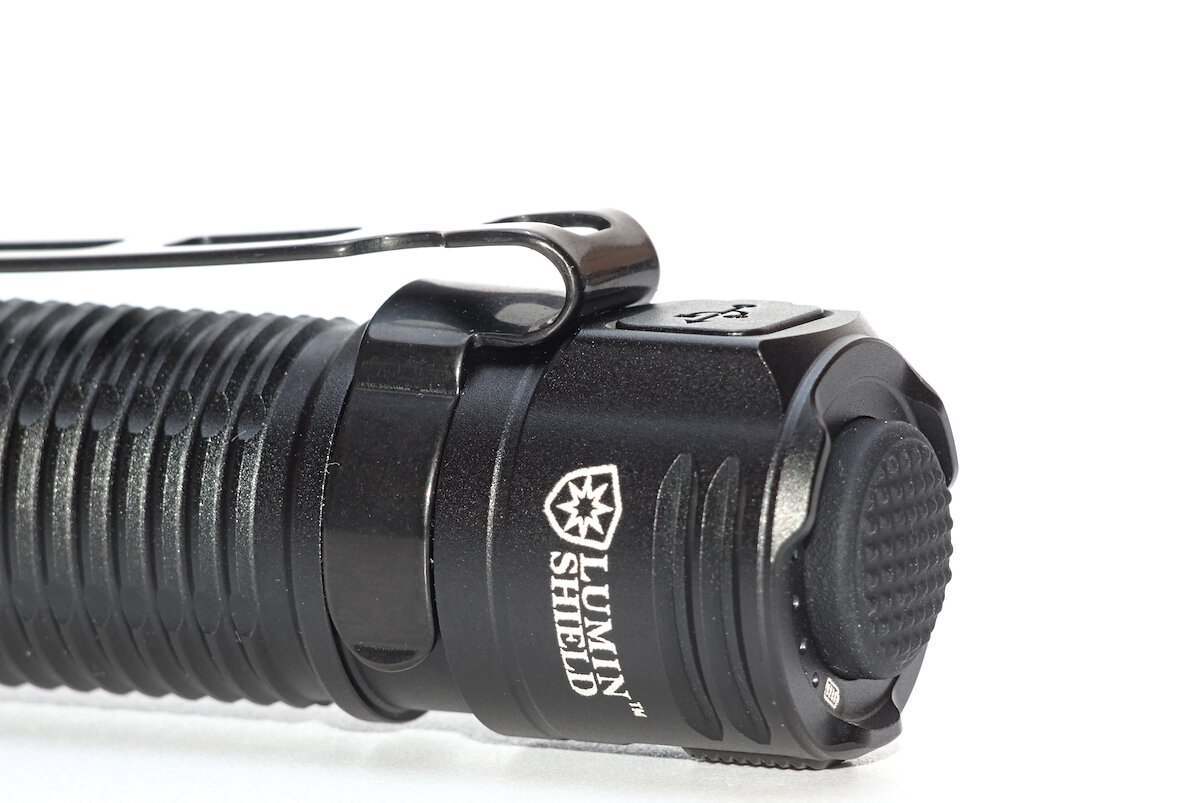
Charging happens at around 2 A, so that the flashlight is fully charged again after just under two hours. Interestingly, there are a few step downs in the charging current, which I have never seen before with any charge controller. However, this has no negative effect on the charging process. The flashlight heats up to around 33 °C during charging.
Progress can be tracked via the four status LEDs next to the switch. During charging they indicate the charging progress, with the current LED flashing. Once charging is complete, all four LEDs light up constantly until the USB cable is disconnected. With the exception of Search and Lumin Shield, all modes can be used during charging.
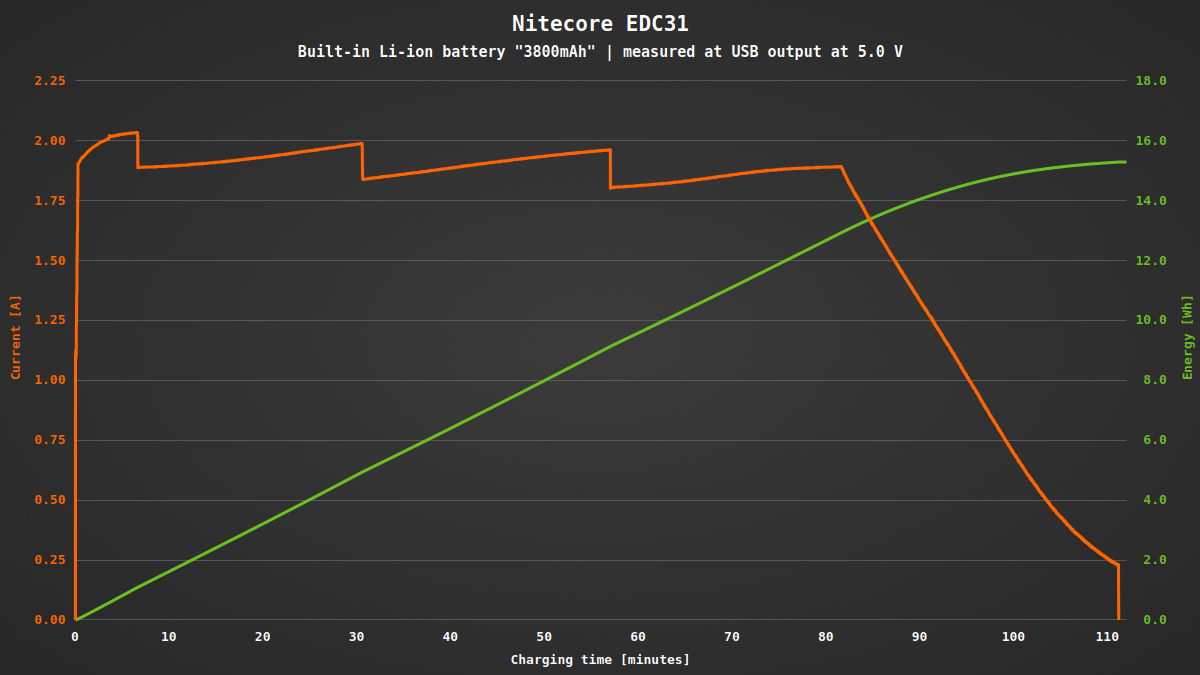
At some point, the performance of the battery will drop. As it is permanently integrated, this may also mean the end of the flashlight. On the other hand, a flashlight like the EDC31 cannot be made easily with a replaceable battery, as the electronics in the rear end of the flashlight require additional cables to the front.
On closer inspection, you can see a small gap on the tailcap and the bezel. They can possibly be unscrewed, but are well glued (you can even see a small amount of the blue adhesive). If the time comes, you can at least try replacing the battery.
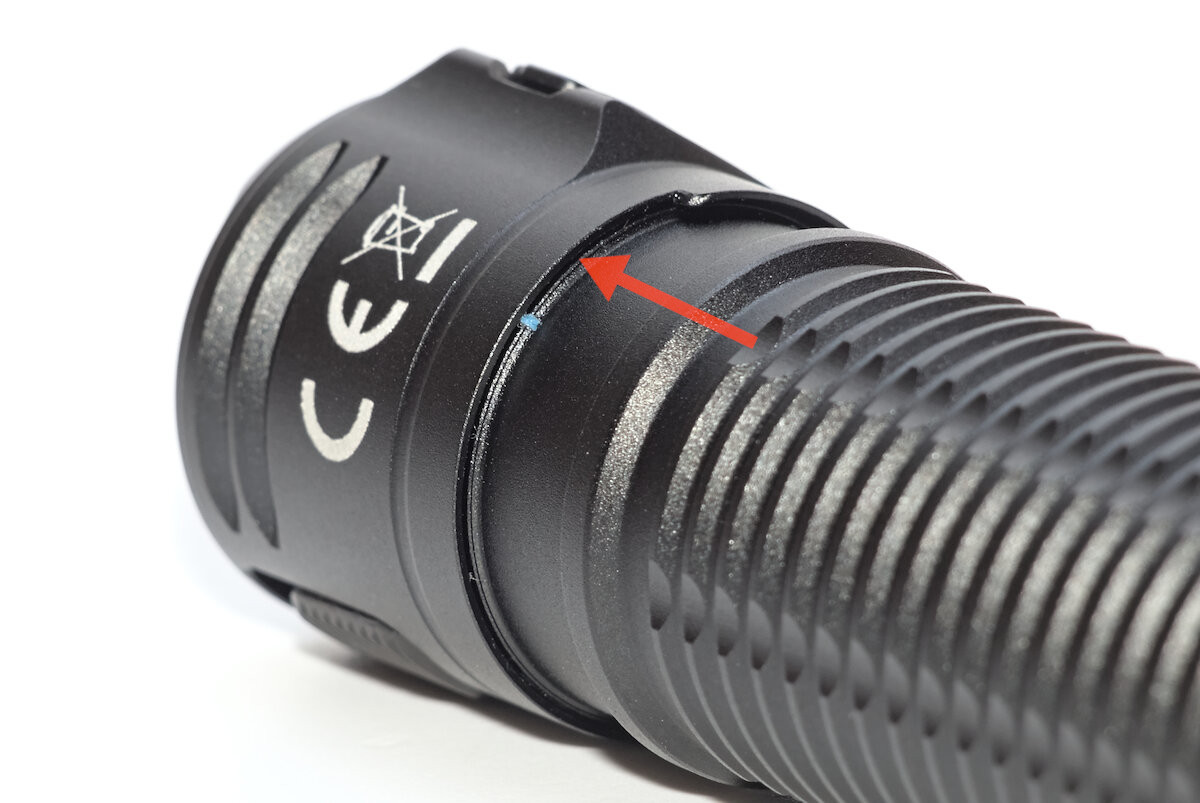

The build quality makes a good impression. According to the specification, the EDC31 is IP68 rated (waterproof to a depth of 2 m) and should withstand drops from a height of up to two meters.
User interface
From a “tactical” flashlight I expect a well thought-out user interface that allows for reliable operation even in stressful situations. The EDC31 has a two-stage, electronic rear switch with a classic silicone cover.
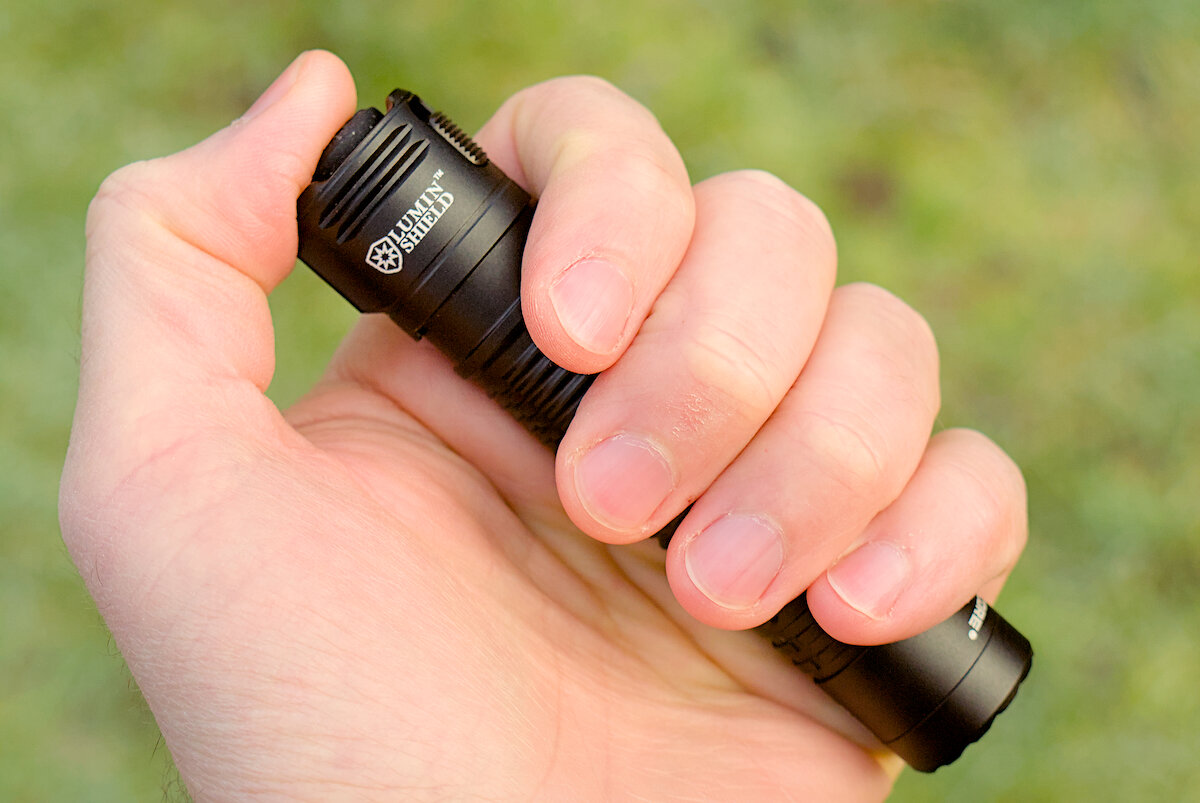
This button allows more than just on and off like a simple mechanical switch. The “Search” and “Lumin Shield” levels are particularly interesting – a type of turbo, which I will explain in more detail in the illumination section.
| State | Action | Function |
|---|---|---|
| Off | Click (1. stage) | Turn on charging indicator for 3 s |
| Off | Click (2. stage) | Turn on (previously used brightness) |
| On | Click (1. stage) | Increase brightness (Ultralow → Low → Mid → High) |
| On | Click (2. stage) | Turn off |
| All | Hold (1. stage) | Search |
| All | Hold (2. stage) | Lumin Shield |
Surprisingly there is no strobe. Unusual for a “tactical” flashlight, but so far I haven’t missed it either.
The flashlight can be locked with a slide switch on the side of the tailcap to prevent it from being switched on accidentally. This system, called “Rapid Lock” by Nitecore, works really well in practice: just pull it down with your thumb and the flashlight is ready. There is no need to press the button several times and the current status can also be seen and felt immediately. It can also be used to turn off the flashlight, so there is no need for extra button presses.
A “Half Lockout Mode” is activated by holding the button while locking. In this mode, Search and Lumin Shield remain accessible, but the flashlight can no longer be switched on permanently.
The switch works with a magnetic sensor. That means that the function can be disrupted by a strong magnet, so that the flashlight can either be switched off or the lockout temporarily deactivated. I don’t see this as a disadvantage for normal use.
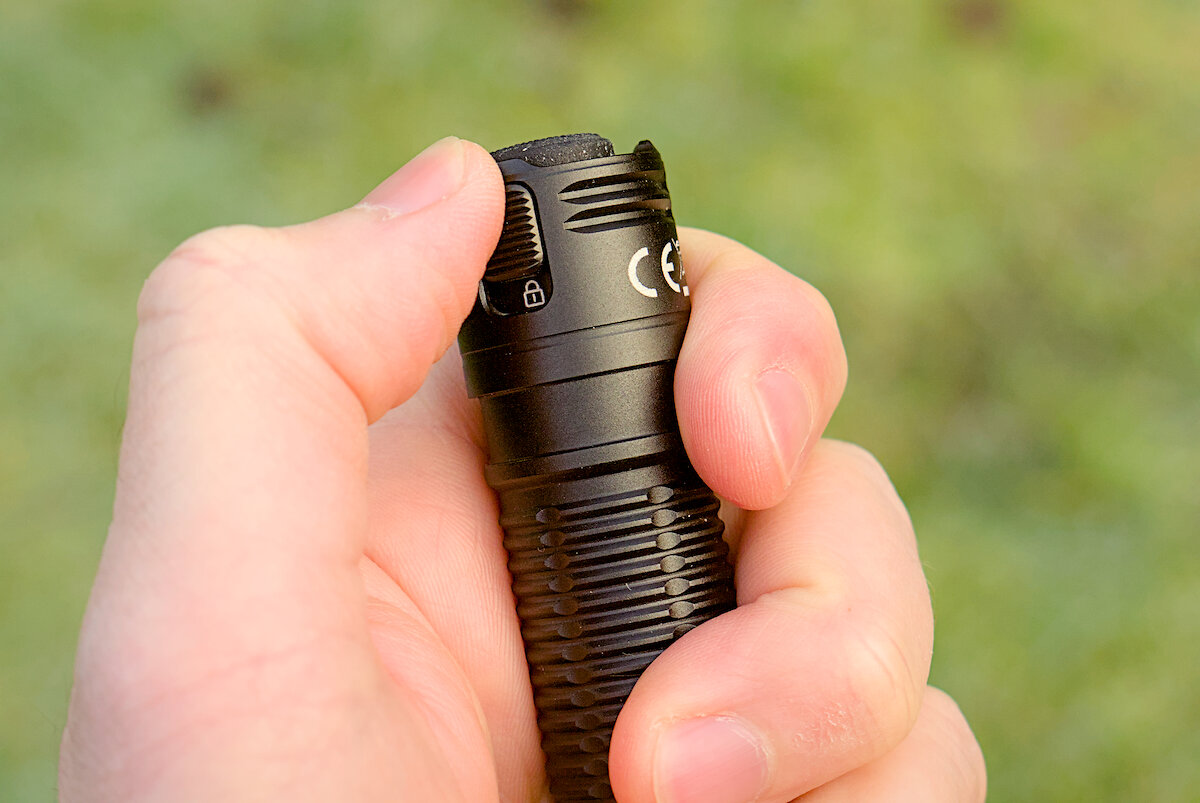
Four green LEDs next to the button indicate the approximate battery level while the flashlight is switched on. When the flashlight is switched off, the button can be briefly tapped up to the first stage to activate the display for three seconds.
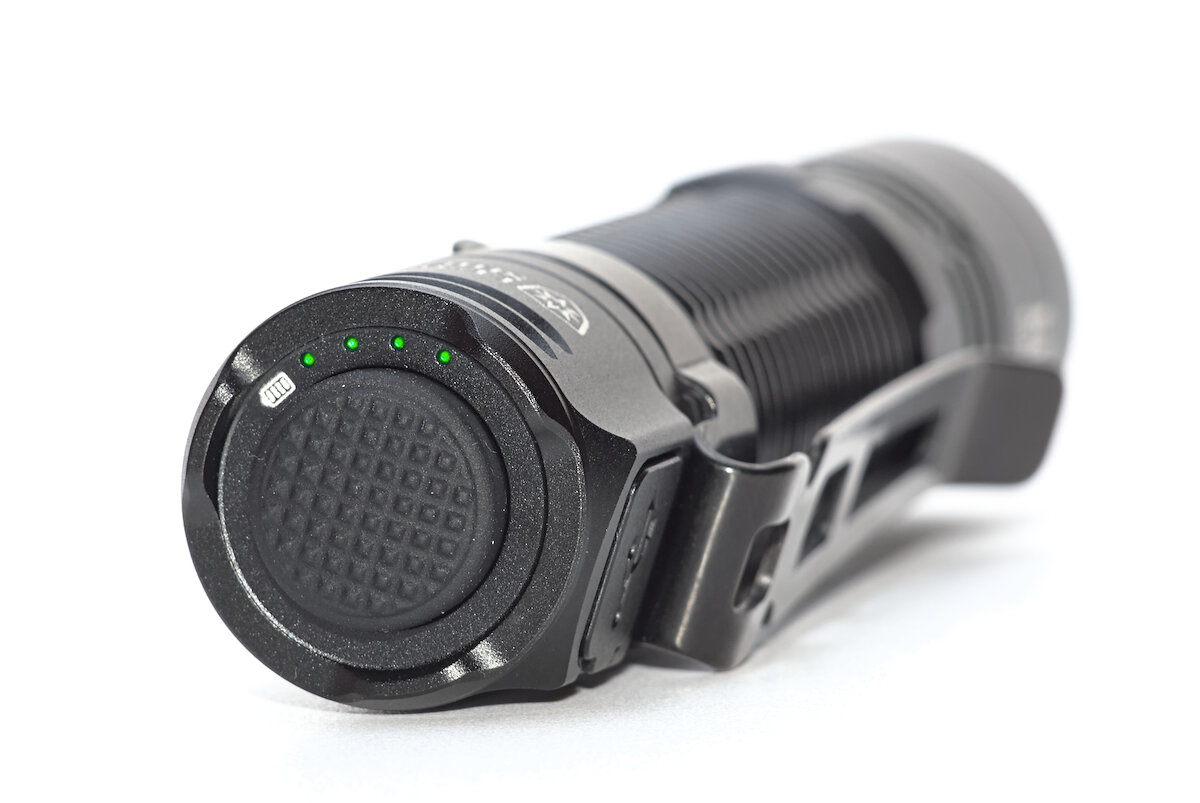
For my taste, the EDC31 is just the right size to be carried comfortably in a pocket. It feels comfortably in the hand, only the opening of the clip is a little annoying. The slide switch for the lockout is reasonably easy to find, as it is located exactly opposite the slightly protruding charging port.

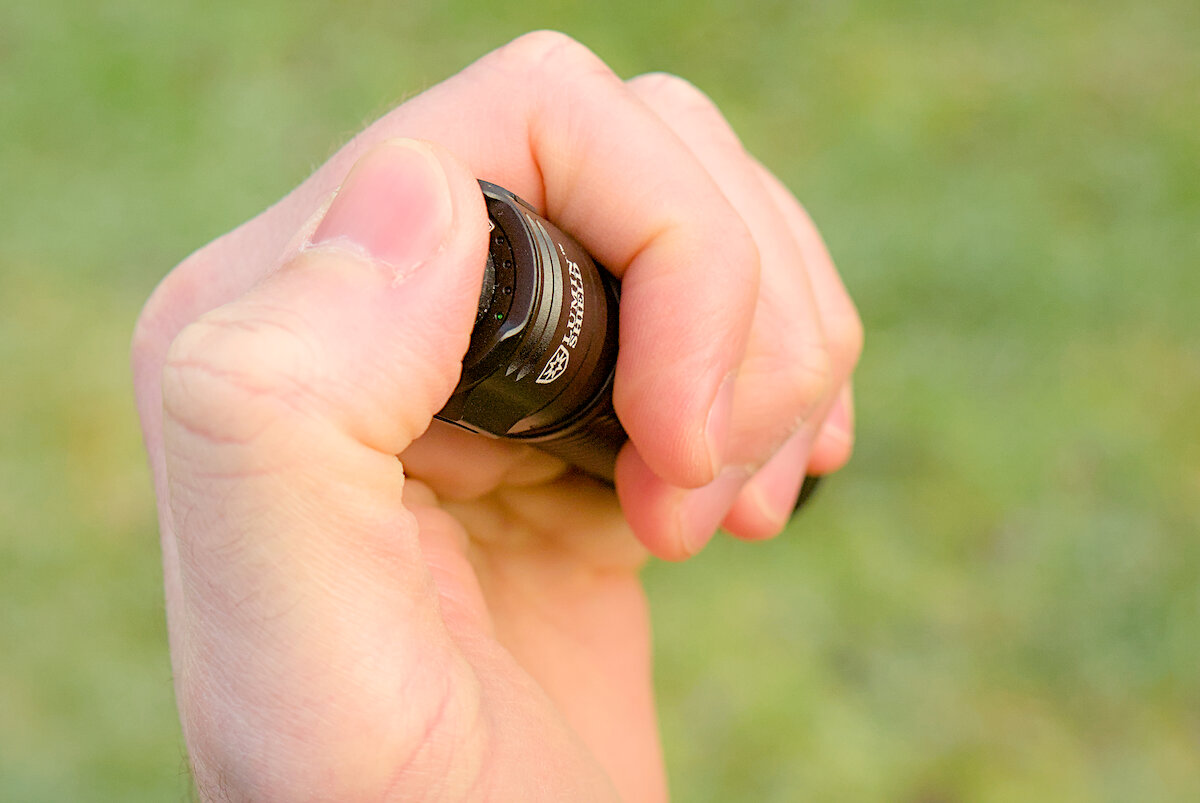

Illumination
The LED sets Nitecore apart from other manufacturers, as it is their own development called “UHi 20 MAX”. The special feature: it consists of nine individual dies, some of which can be controlled independently of each other.
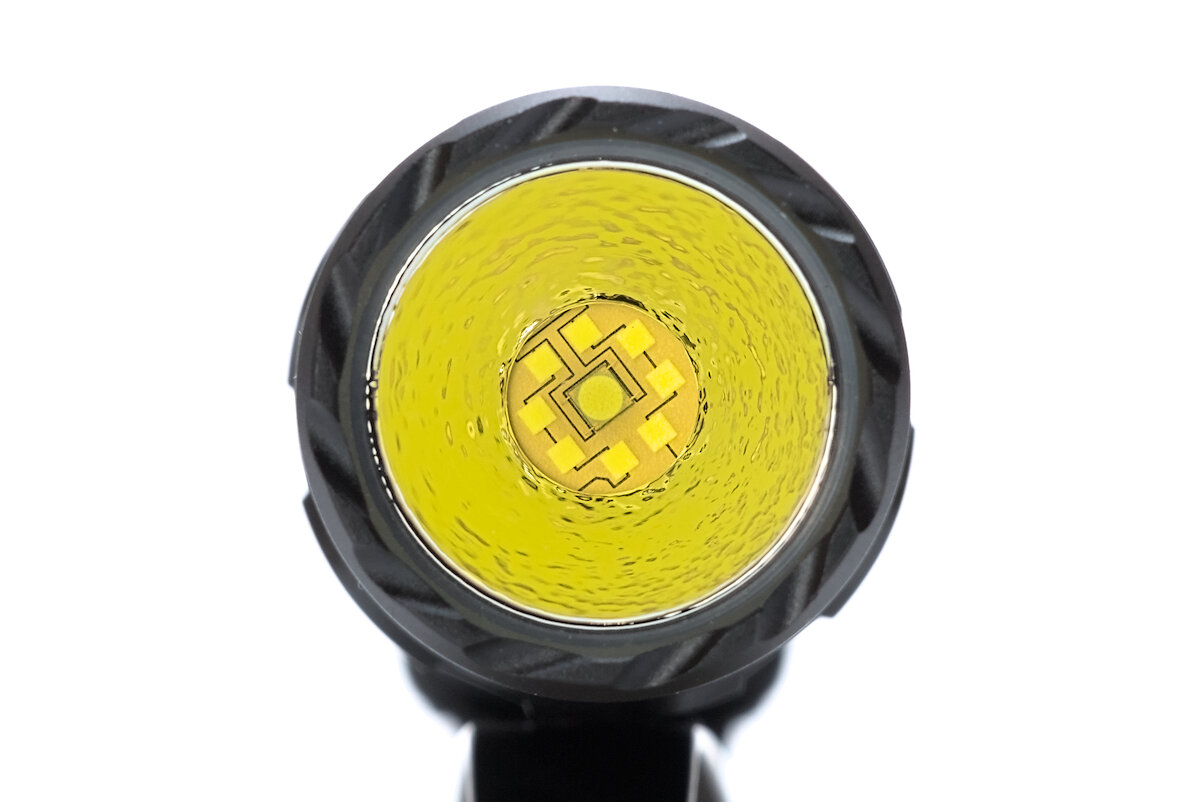
In the center is a die with a small, round light emitting surface. This makes it easy to focus and ideal for a thrower. It is surrounded by eight other dies, which increases the effective LES of the LED, making it significantly more floody. A textured reflector (“orange peel”) smoothes the beam so that the outer dies merge completely with each other.
In the Ultralow, Low, Mid and Search levels, only the middle die is used, resulting in a relatively narrow beam. In High and Lumin Shield, the outer chips are also switched on, resulting in an extremely bright spill. This also explains the name “Lumin Shield”: A wall of bright light, which is designed to dazzle and distract an attacker.
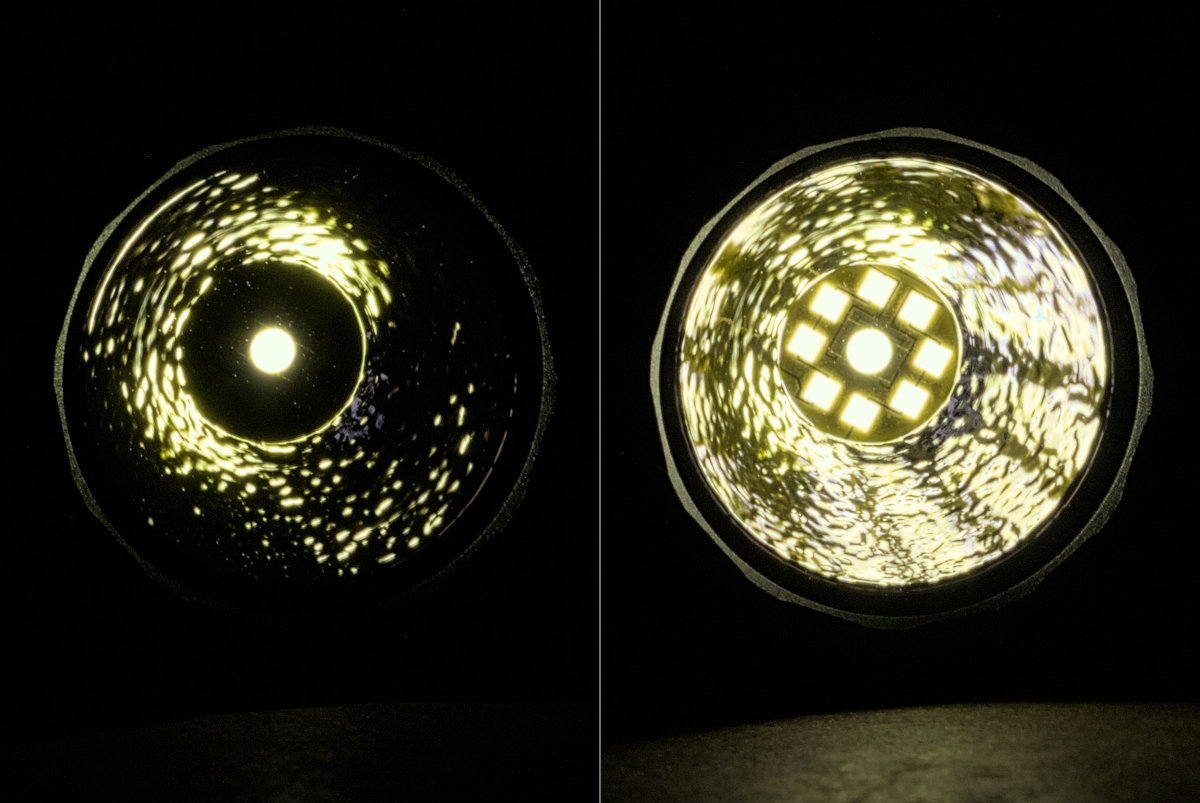
Unfortunately the choice of dies used is linked to the brightness levels. It would have been nice to be able to choose between a wide and a narrow beam at all levels. Especially at low levels and at short distances, the beam is too narrow for my taste.
Depending on the level, the color temperature is around 6000 K. In the lower levels, a slightly greenish tint can be seen, which disappears in Search and Lumin Shield.
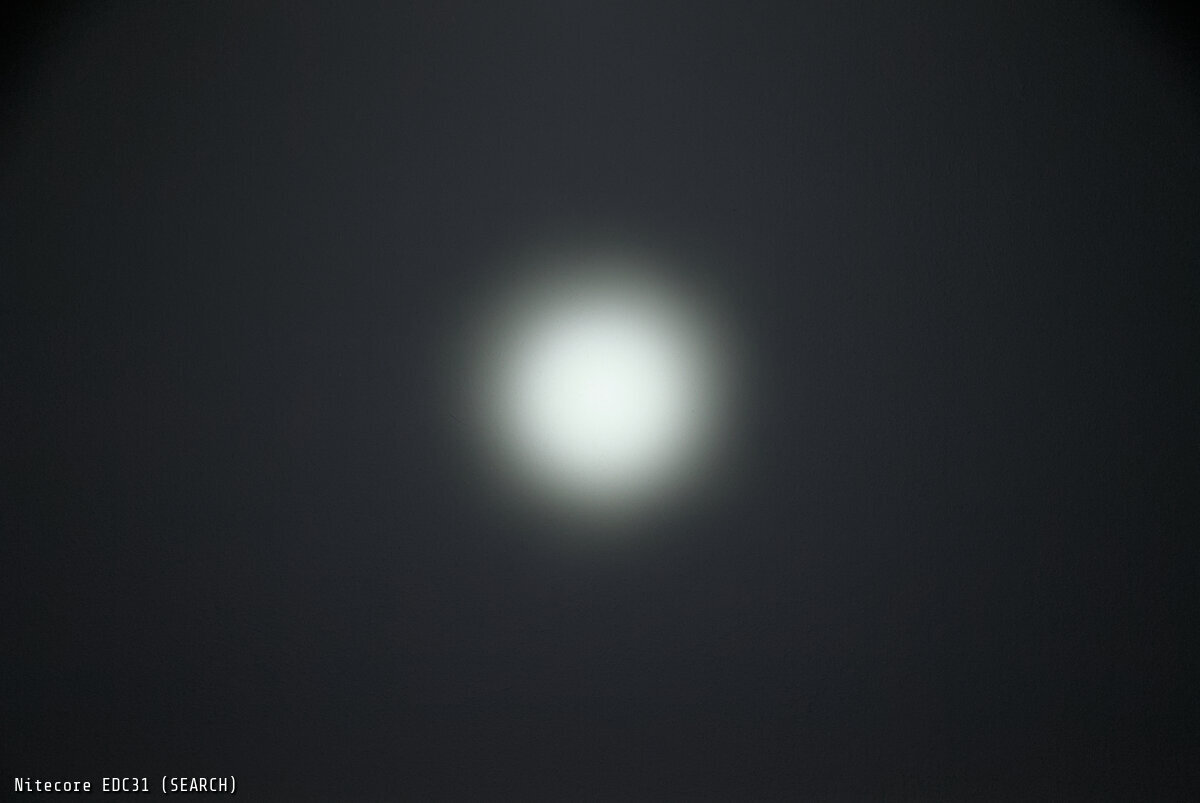
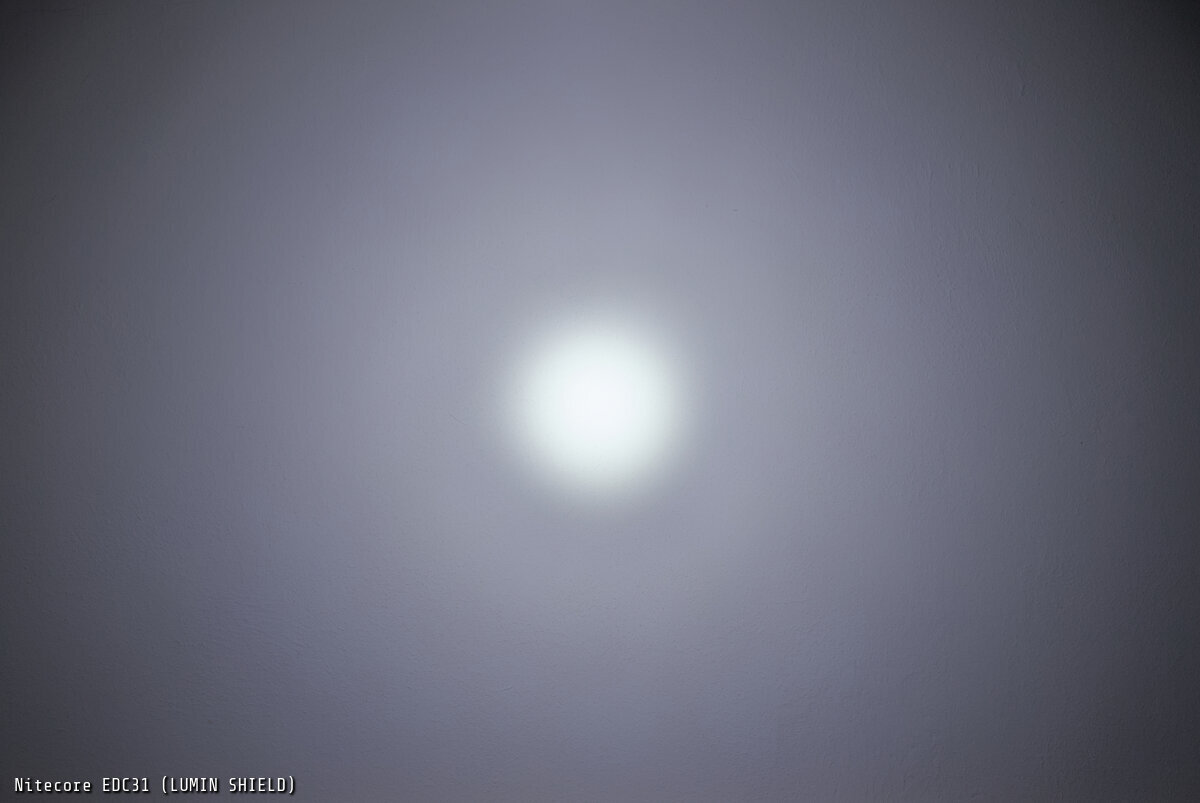
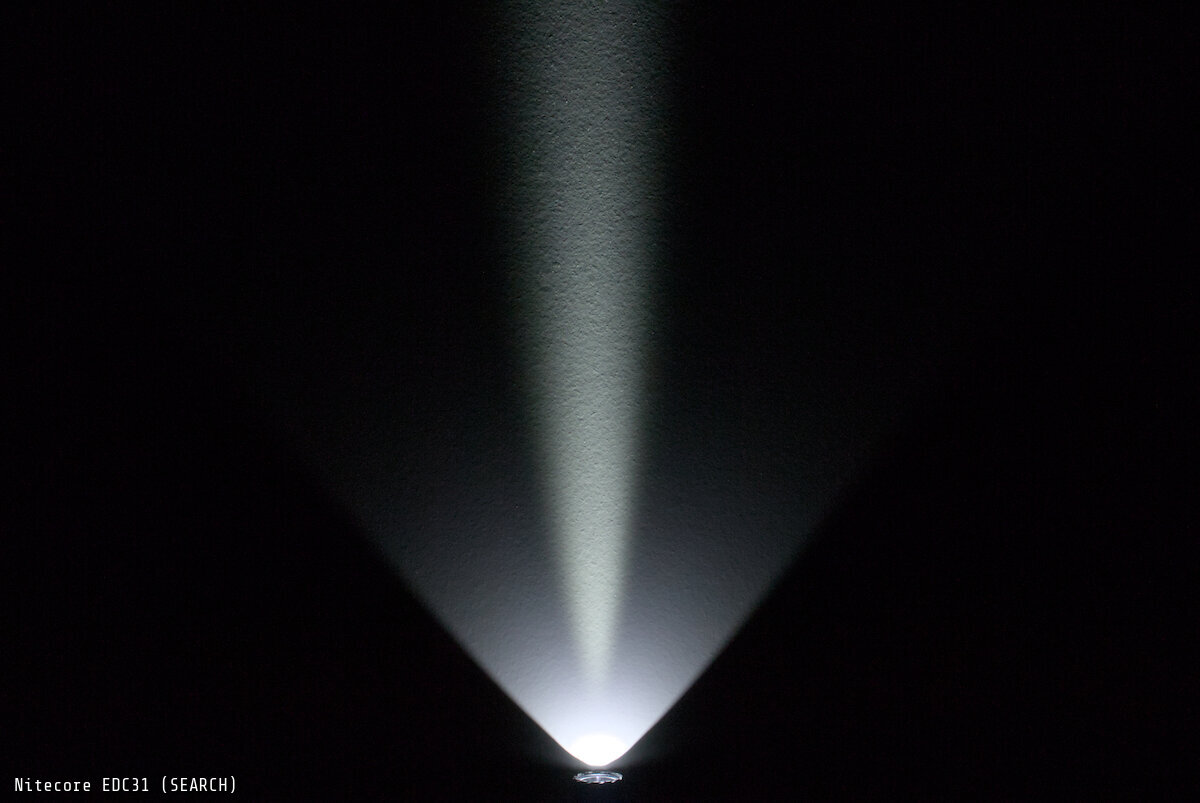
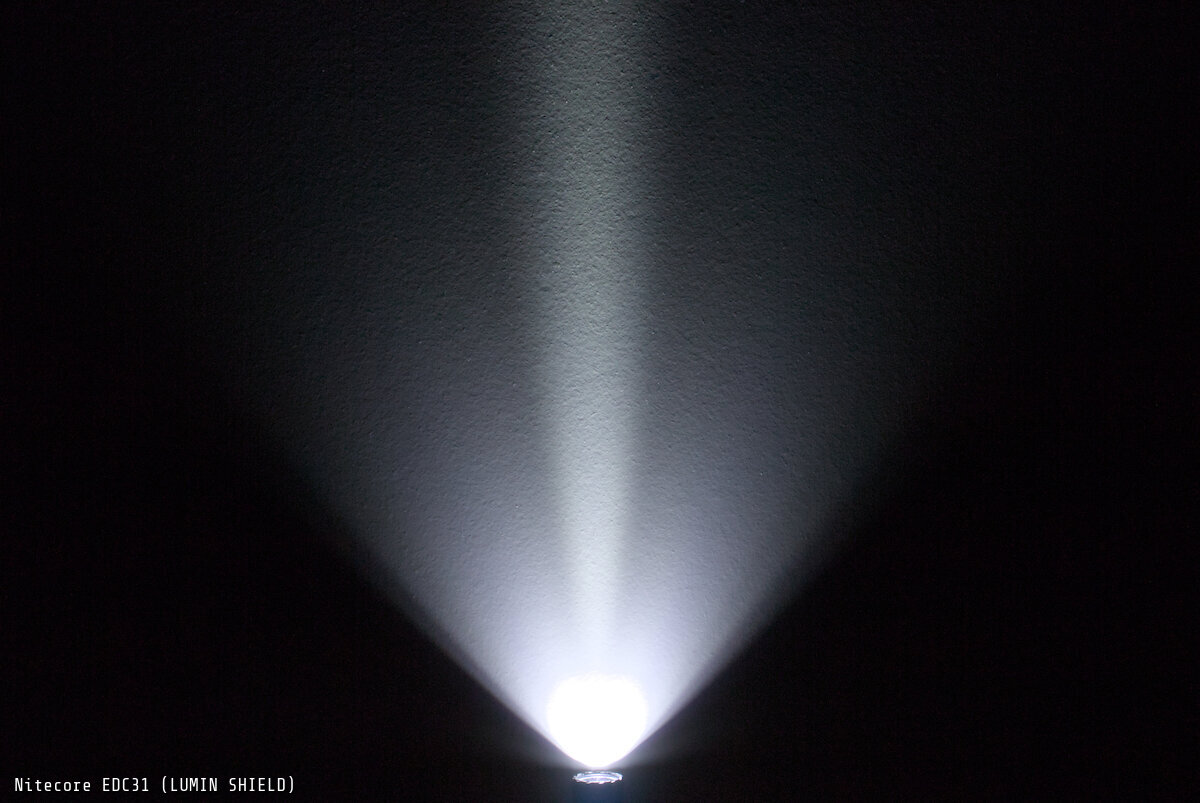
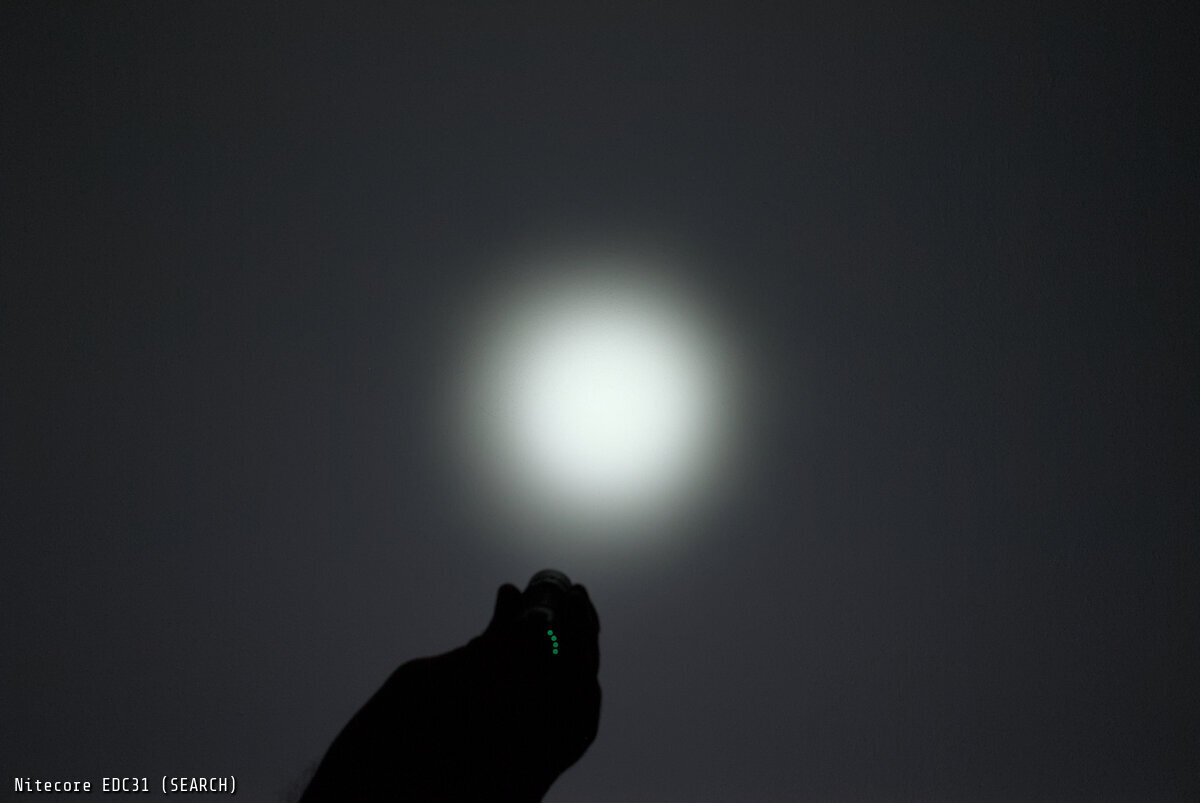
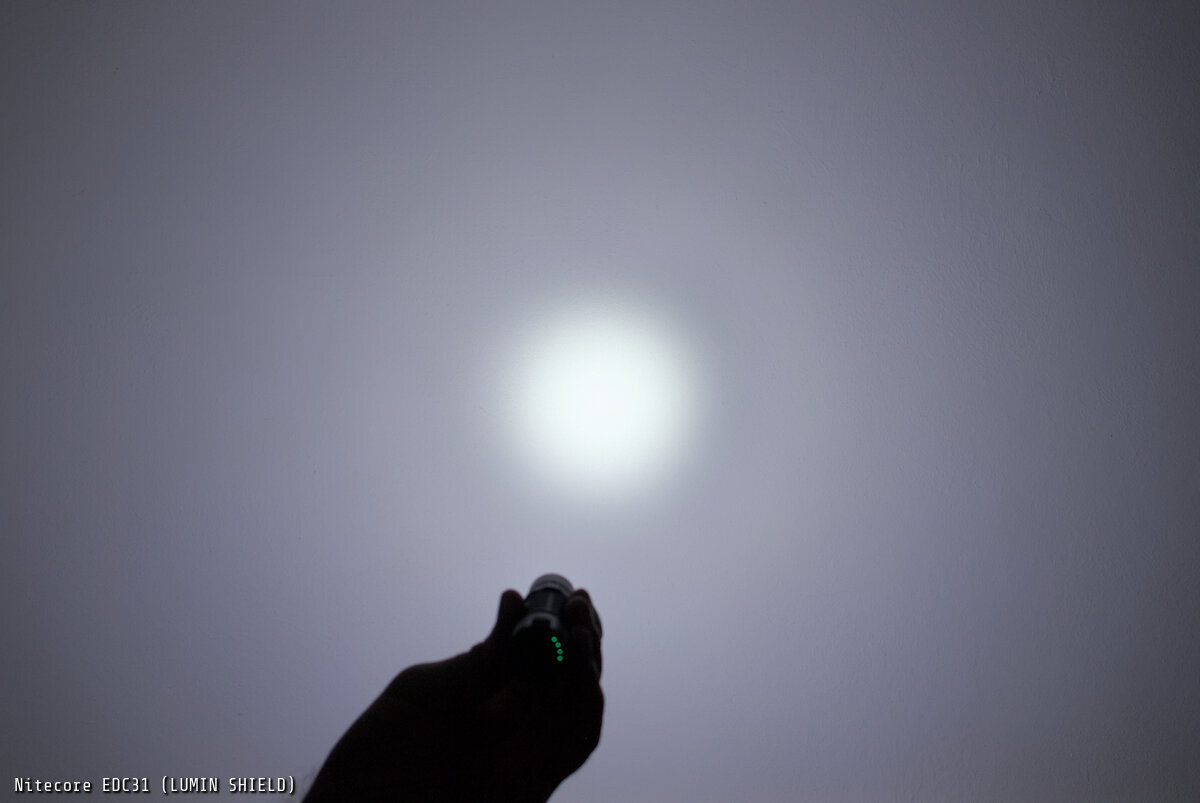
For the outdoor beamshots, I used the Nitecore EDC23 for comparison. In “Search” mode, the EDC31 has slightly more throw, but also has a narrower beam and does not illuminate the surroundings as well as the EDC23. In “Lumin Shield” mode, the EDC31 scores with a higher overall brightness and also outperforms the EDC23 at close range.
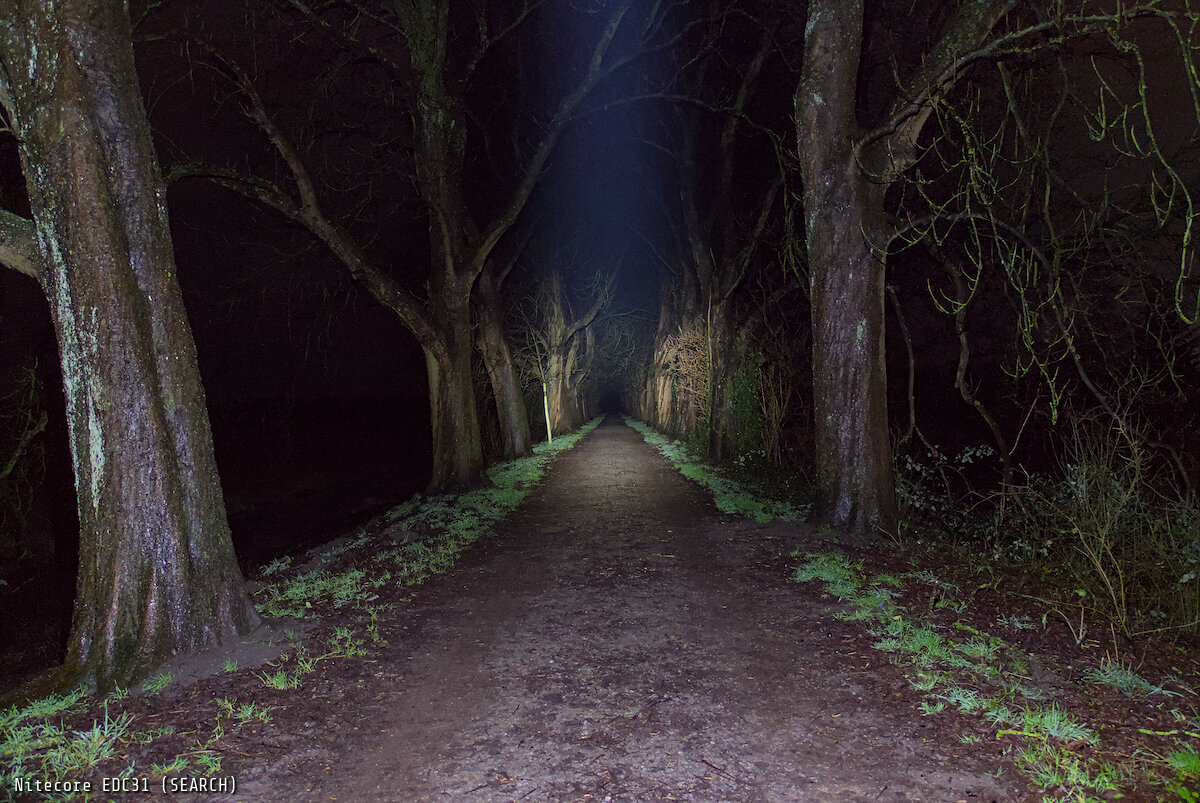
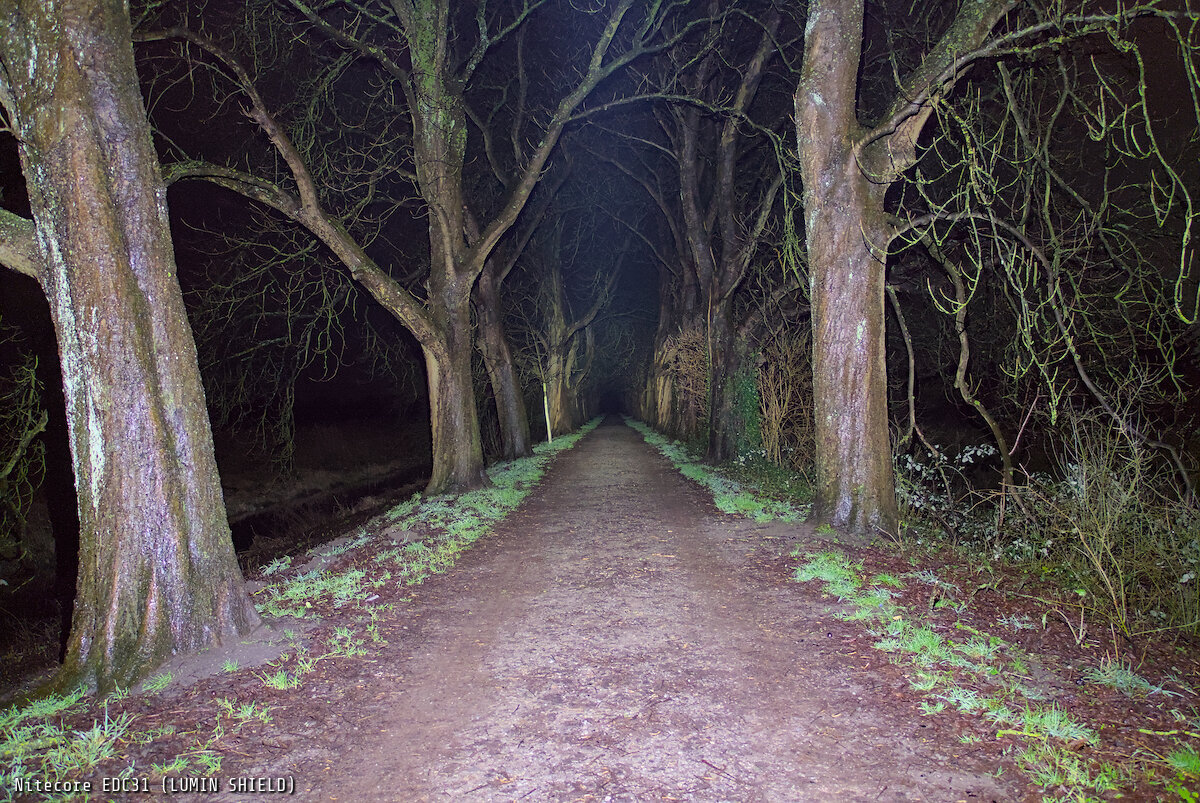
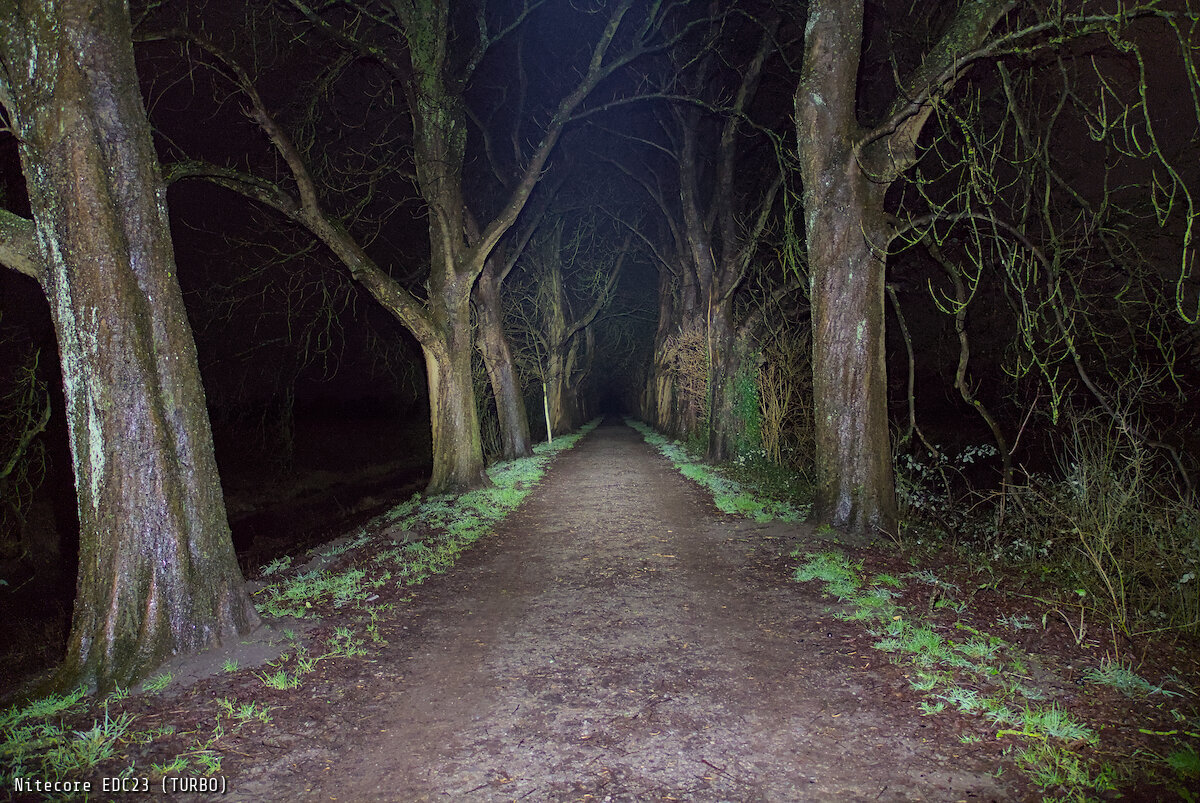
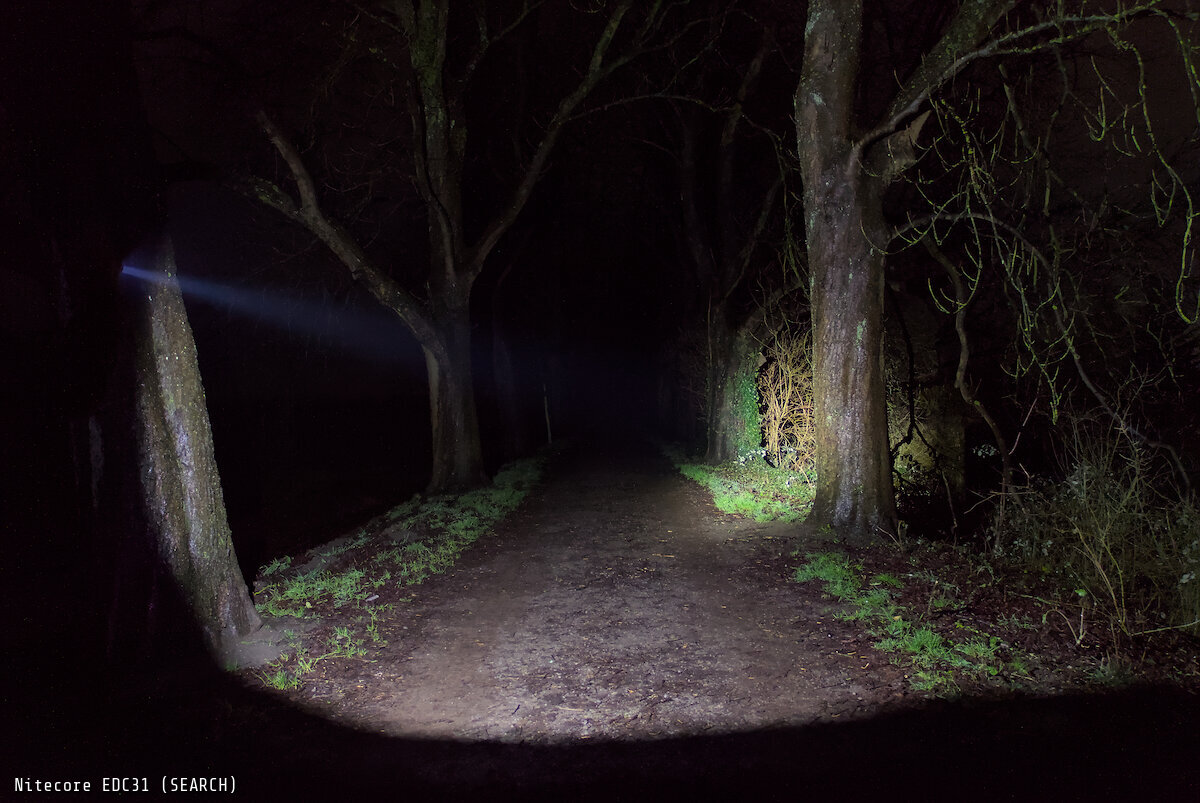
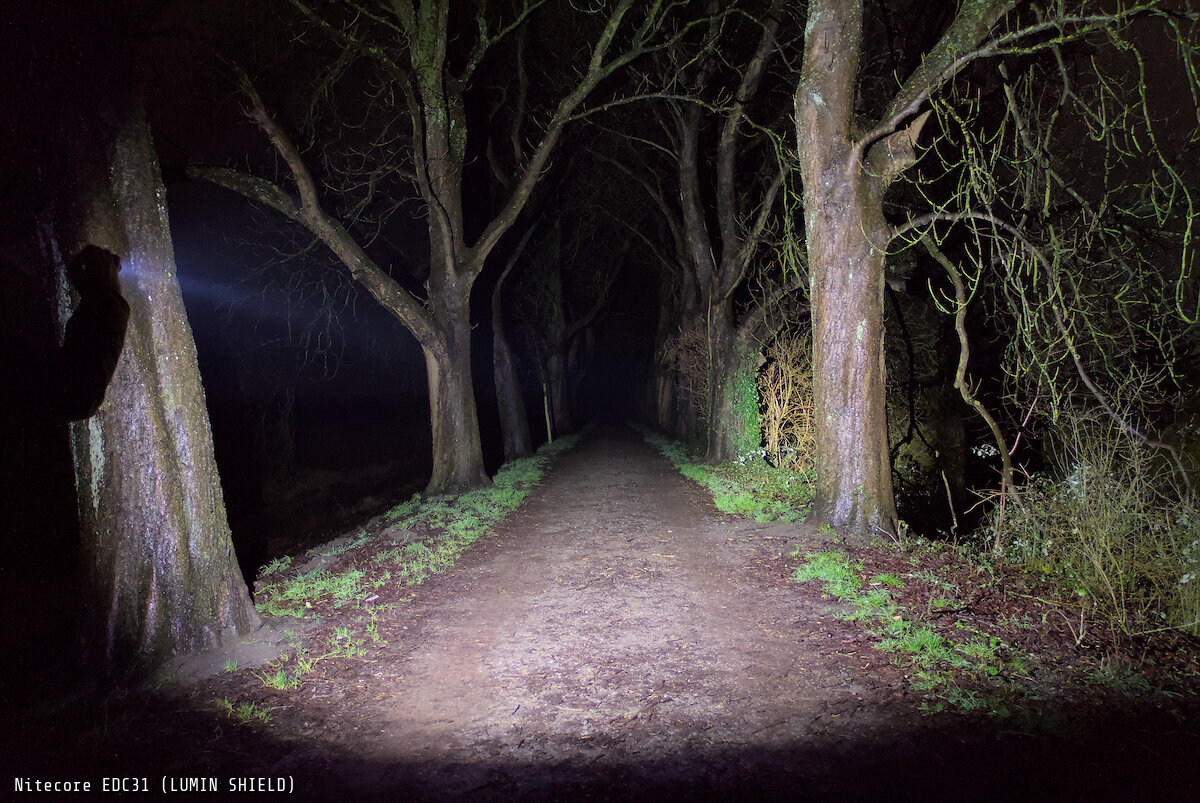
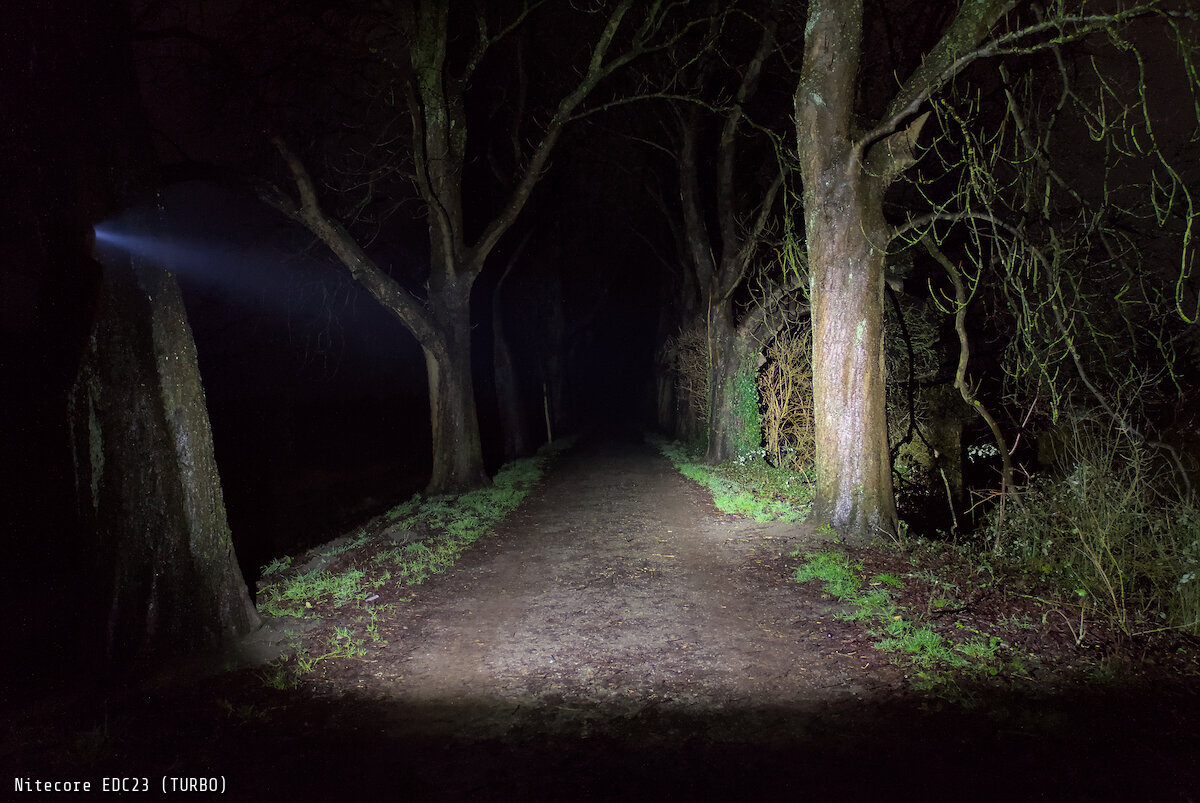
Driver and runtime
A constant current driver ensures efficient operation of the flashlight with mostly constant brightness. The manufacturer’s specifications already indicate that the flashlight is optimized for throw. It is noticeable that the range with Lumin Shield is somewhat shorter than with Search, as all the LEDs have to share the current.
| Mode | Brightness¹ | Runtime¹ | Intensity¹ (Throw²) |
|---|---|---|---|
| Lumin Shield | 3500 lm | ––– | 28 800 cd (330 m) |
| Search | 1500 lm | ––– | 35 630 cd (380 m) |
| High | 1100 lm | 4 h | 10 098 cd (200 m) |
| Mid | 300 lm | 5 h | 7 489 cd (173 m) |
| Low | 70 lm | 24 h | 1 826 cd (85 m) |
| Ultralow | 5 lm | 57 h | 109 cd (20 m) |
¹ According to manufacturer ² ANSI FL1
According to the manufacturer, the EDC31 achieves 3500 lm in Lumin Shield – at least for a few seconds. Even in Search and High, the flashlight heats up relatively quickly and has to reduce the brightness in order not to overheat. In the other modes however, the brightness is kept nice and constant.

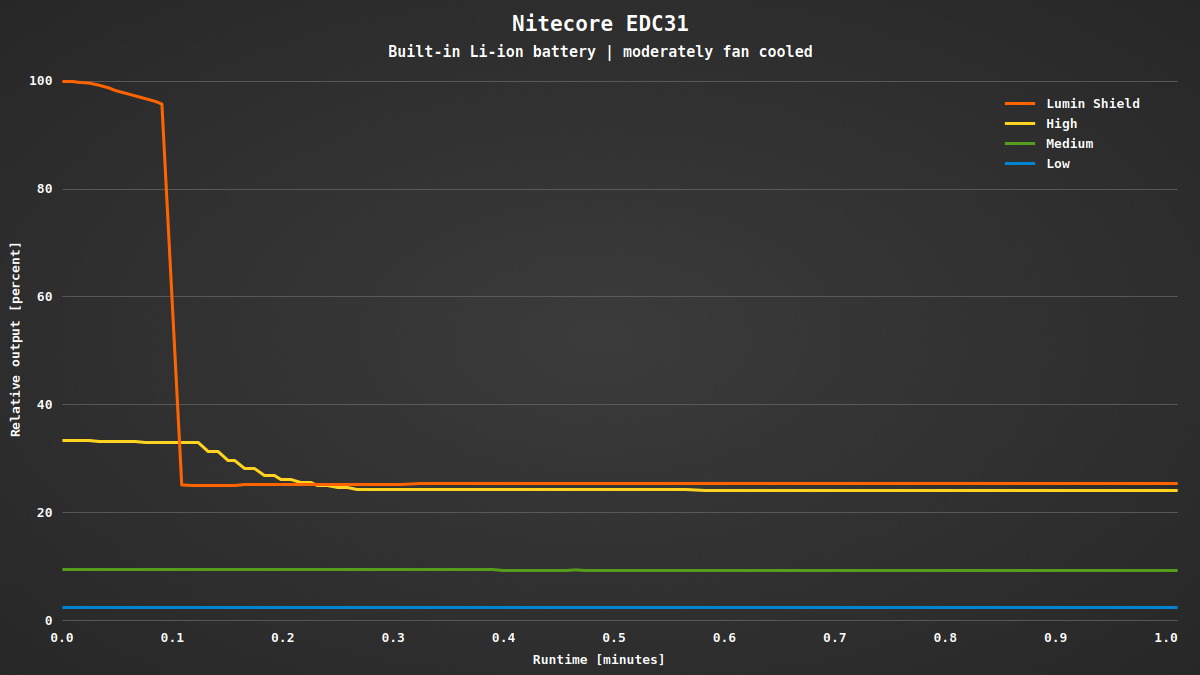
As the flashlight also has temperature regulation, cooling plays a certain role in the brightness and runtime. Without cooling – and thus lower brightness – the runtime in High comes closer to the manufacturer’s specifications.
I’m a little disappointed by the rapid reduction in brightness of High after just nine seconds, even though the flashlight isn’t really hot yet. The brightness could have been maintained for a minute in my opinion.
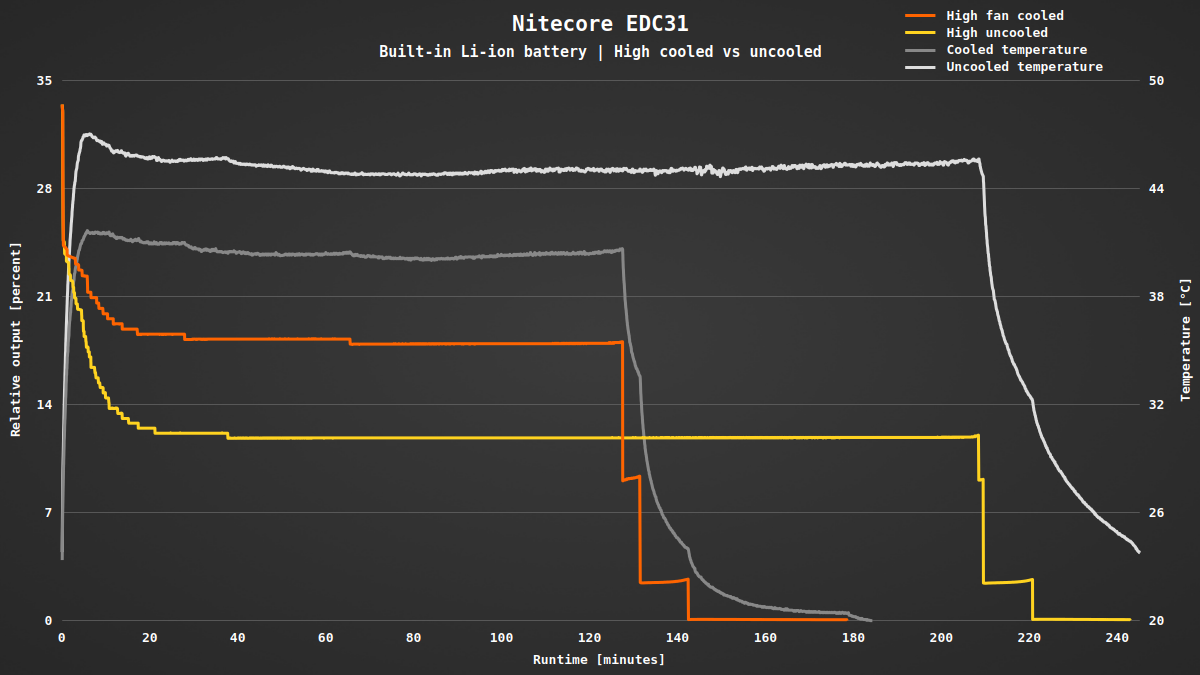
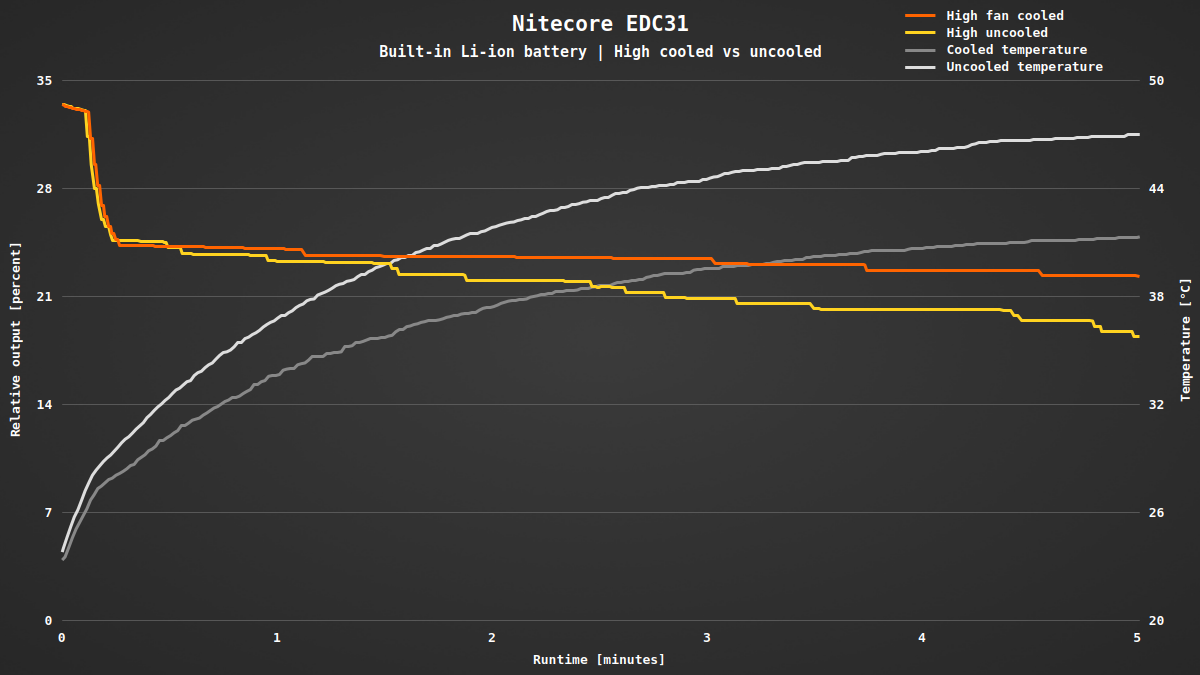
In both Search and Lumin Shield, the brightness is reduced after eight seconds. The brightness is then gradually reduced further depending on the temperature.
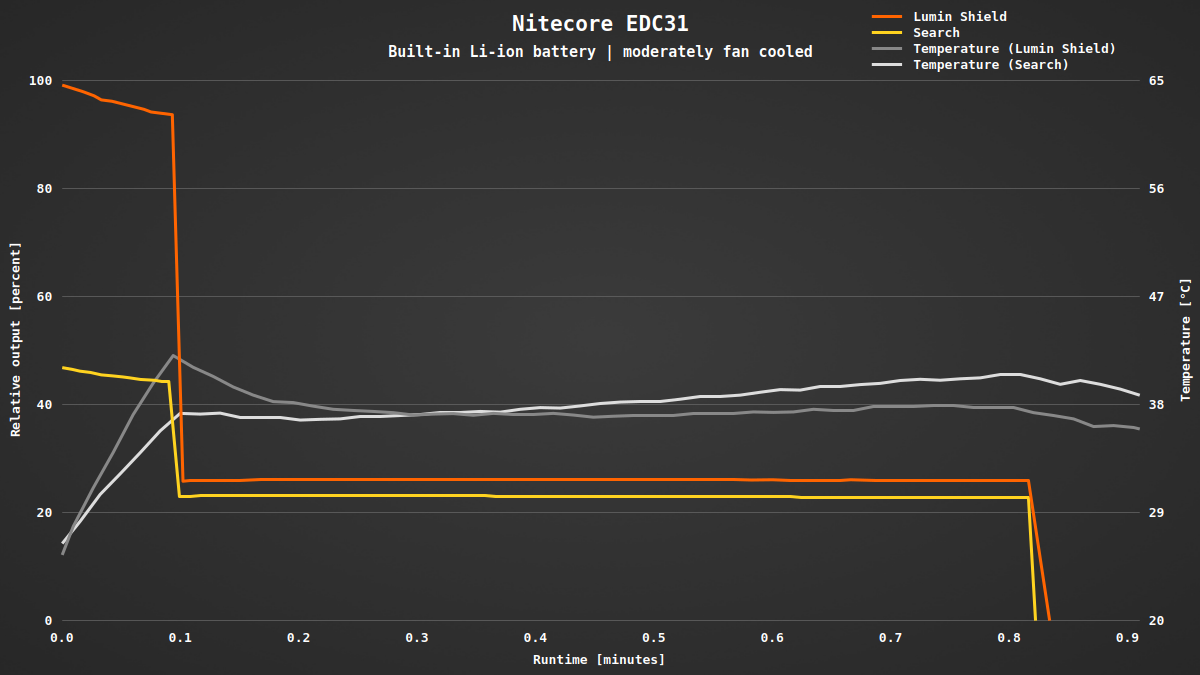
If you activate these turbo modes more than once or twice in succession, the flashlight quickly becomes so hot that you can barely hold it. According to measurements, it reaches almost 65 °C.
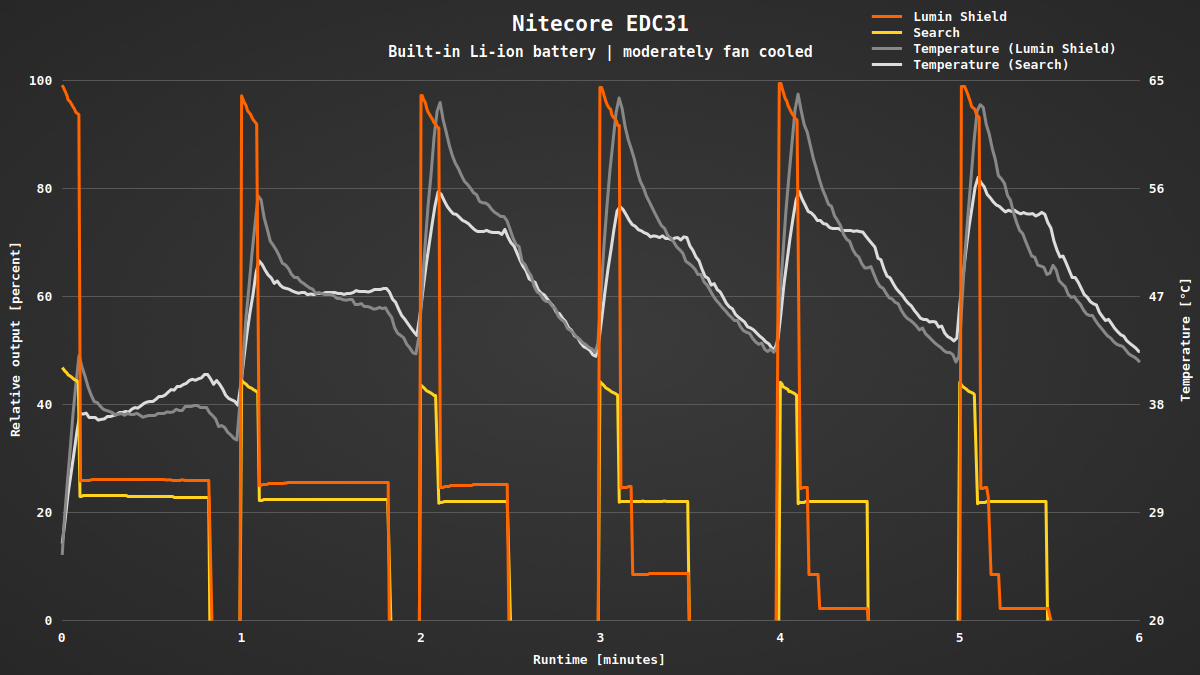

All levels are regulated by the constant current driver without PWM. I was unable to measure the power consumption due to the permanently installed battery. There is protection against deep discharge, as the flashlight turns off at some point.
Conclusion
When you first see the Nitecore EDC31, it may not appear that special. But a closer look reveals its special secrets. A compact EDC flashlight with a touch of tactical flair, a rather unusual LED with nine dies and a super simple control scheme with a two-stage electronic switch. While most modes are optimized for throw, the “Lumin Shield” mode impresses with a bright and floody wall of light. I also like lockout with a slide switch, called “Rapid Lock”.
Given the compact design, it is not surprising that the flashlight heats up quickly and cannot maintain the high brightness for long. In the lower levels however, the constant current driver keeps the brightness pretty constant. Unfortunately it is not possible to choose freely between the wide and narrow beam for each brightness level. The permanently installed rechargeable battery can also be seen as a disadvantage.
Got curious? Here you can find the Nitecore EDC31 in the official Nitecore US store.
